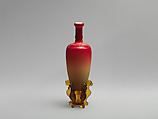“Morgan Vase” and stand
Manufacturer Hobbs, Brockunier and Company American
The second half of the nineteenth century witnessed a proliferation of highly ornamental decorative arts in nearly every medium. Glassmakers during this period experimented with new techniques, introducing bold color effects and embracing exotic influences. Many new lines of art glass imitated other materials. This particular form was made in imitation of the “Morgan Vase,” the famous eighteenth-century Chinese porcelain vase with a peachblow glaze from the collection of Mrs. Mary Morgan, which sold at auction in 1886 for the astonishing price of $18,000. Hobbs, Brockunier & Company was one of a number of glass firms to capitalize on this event and the company created a copy of the vase with their perfected Amberina glass, relating in shape and size to the Chinese porcelain example. The amber pressed glass base on which this vase sits imitates the carved wood base of the original.
Due to rights restrictions, this image cannot be enlarged, viewed at full screen, or downloaded.

